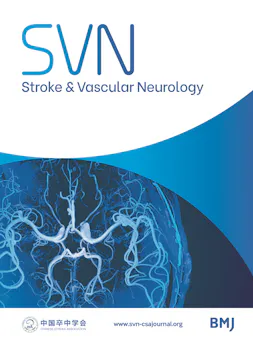Association between ASPECTS region of infarction and clinical outcome in non-acute large vessel occlusion ischaemic stroke after endovascular recanalisation
IF 4.9
1区 医学
Q1 CLINICAL NEUROLOGY
引用次数: 0
Abstract
Purpose This study retrospectively investigated whether infarction in specific Alberta Stroke Program Early CT Score (ASPECTS) regions is associated with clinical outcome in patients with symptomatic non-acute internal carotid or middle cerebral artery occlusion who underwent endovascular recanalisation (ER). Methods Preoperative ASPECTS and region of infarction were recorded before recanalisation. Clinical outcome was evaluated 90 days after the procedure using the modified Rankin Scale; a score>2 was defined as poor outcome. Secondary outcomes included postprocedural cerebral oedema, intracranial haemorrhage (ICH) and symptomatic ICH. Results Among the 86 patients included, 90-day outcome was poor in 30 (34.9%) and 40 experienced cerebral oedema (46.5%). Multivariate logistic regression models showed that lenticular nucleus infarction (OR 19.61–26.00, p<0.05), admission diastolic blood pressure (OR 1.07–1.08, p<0.05), preprocedural National Institutes of Health Stroke Scale (OR 1.96–2.05, p<0.001) and haemorrhagic transformation (OR 14.99–18.81, p<0.05) were independent predictors of poor 90-day outcome. The area under the receiver operating characteristic curve for lenticular nucleus infarction as a predictor of poor outcome was 0.73. M2 region infarction (OR 26.07, p<0.001) and low American Society of Interventional and Therapeutic Neuroradiology/Society of Interventional Radiology collateral circulation grade (OR 0.16, p=0.001) were independent predictors of postprocedural cerebral oedema. The area under the receiver operating characteristic curve for M2 region infarction as a predictor of cerebral oedema was 0.64. Region of infarction did not significantly differ between patients with and without postprocedural ICH or symptomatic ICH. Conclusions Lenticular nucleus and M2 region infarction were independent predictors of poor 90-day outcome and postprocedural cerebral oedema, respectively, in patients with non-acute anterior circulation large artery occlusion who underwent ER. Data are available on reasonable request. The datasets generated during and/or analysed during the current study are available from the corresponding author on reasonable request.血管内再通术后非急性大血管闭塞缺血性卒中患者 ASPECTS 梗死区域与临床预后的关系
目的 本研究回顾性调查了接受血管内再通术(ER)的无症状非急性颈内动脉或大脑中动脉闭塞患者,其特定阿尔伯塔卒中计划早期 CT 评分(ASPECTS)区域的梗死是否与临床预后有关。方法 在血管再通手术前记录术前 ASPECTS 和梗死区域。术后90天采用改良Rankin量表评估临床疗效;评分大于2分为疗效不佳。次要结果包括术后脑水肿、颅内出血(ICH)和无症状 ICH。结果 在纳入的 86 名患者中,30 人(34.9%)90 天预后不良,40 人(46.5%)出现脑水肿。多变量逻辑回归模型显示,晶状体核梗死(OR 19.61-26.00,P<0.05)、入院舒张压(OR 1.07-1.08,P<0.05)、术前美国国立卫生研究院卒中量表(OR 1.96-2.05,P<0.001)和出血转化(OR 14.99-18.81,P<0.05)是不良 90 天预后的独立预测因素。光栅核梗死作为不良预后预测因子的接收者操作特征曲线下面积为 0.73。M2区域梗死(OR 26.07,p<0.001)和美国介入与治疗神经放射学会/介入放射学会侧支循环分级低(OR 0.16,p=0.001)是预测术后脑水肿的独立指标。M2区域梗死预测脑水肿的接收器操作特征曲线下面积为0.64。术后 ICH 或无症状 ICH 患者的梗死区域无明显差异。结论 在接受急诊室手术的非急性前循环大动脉闭塞患者中,晶状体核和M2区域梗死分别是90天不良预后和术后脑水肿的独立预测因子。如有合理要求,可提供相关数据。本研究中生成和/或分析的数据集可向通讯作者索取。
本文章由计算机程序翻译,如有差异,请以英文原文为准。
求助全文
约1分钟内获得全文
求助全文
来源期刊

Stroke and Vascular Neurology
Medicine-Cardiology and Cardiovascular Medicine
CiteScore
11.20
自引率
1.70%
发文量
63
审稿时长
15 weeks
期刊介绍:
Stroke and Vascular Neurology (SVN) is the official journal of the Chinese Stroke Association. Supported by a team of renowned Editors, and fully Open Access, the journal encourages debate on controversial techniques, issues on health policy and social medicine.
 求助内容:
求助内容: 应助结果提醒方式:
应助结果提醒方式:


